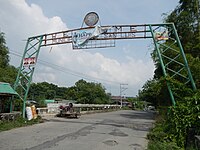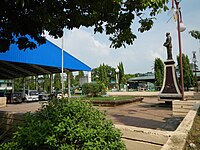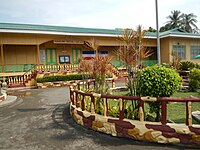Contents
San Luis, officially the Municipality of San Luis (Tagalog: Bayan ng San Luis), is a 4th class municipality in the province of Batangas, Philippines. According to the 2020 census, it has a population of 36,172 people.[3]
Etymology
No reliable information could be gathered as to why the town is called San Luis. However, some people believe that it was named as such because it was established during the feast of Saint Louis.[5][6]
History
San Luis was historically part of Taal. It was established as an independent town on August 25, 1861. However, in 1903,[7] due to small income, the town was made a part of Taal once again, with all the barrios in existence retaining their names, while the town center (poblacion) was reverted to its Spanish-era name Balibago. On February 2, 1918, San Luis was re-established.[8]
In 1961, the barrios of Pacifico and Sampa were separated from San Luis and annexed to the new municipality of Santa Teresita.[9]
Geography
According to the Philippine Statistics Authority, the municipality has a land area of 42.56 square kilometers (16.43 sq mi) [10], constituting 1.36% of the 3,119.75-square-kilometer (1,204.54 sq mi) total area of Batangas.
Barangays
San Luis is politically subdivided into 26 barangays.[11] Each barangay consists of puroks and some have sitios.
| PSGC | Barangay | Population | ±% p.a. | |||
|---|---|---|---|---|---|---|
| 2020[3] | 2010[12] | |||||
| 041024001 | Abiacao | 3.2% | 1,146 | 1,052 | 0.86% | |
| 041024002 | Bagong Tubig | 5.0% | 1,818 | 1,778 | 0.22% | |
| 041024003 | Balagtasin | 1.6% | 561 | 534 | 0.49% | |
| 041024004 | Balite | 2.8% | 997 | 942 | 0.57% | |
| 041024005 | Banoyo | 6.3% | 2,294 | 2,066 | 1.05% | |
| 041024006 | Boboy | 4.2% | 1,502 | 1,480 | 0.15% | |
| 041024007 | Bonliw | 3.2% | 1,145 | 1,002 | 1.34% | |
| 041024008 | Calumpang West | 3.3% | 1,186 | 1,081 | 0.93% | |
| 041024009 | Calumpang East | 4.0% | 1,464 | 1,430 | 0.24% | |
| 041024010 | Dulangan | 7.9% | 2,868 | 2,818 | 0.18% | |
| 041024011 | Durungao | 1.8% | 665 | 621 | 0.69% | |
| 041024012 | Locloc | 1.3% | 458 | 534 | −1.52% | |
| 041024013 | Luya | 3.4% | 1,229 | 1,063 | 1.46% | |
| 041024014 | Mahabang Parang | 2.0% | 734 | 602 | 2.00% | |
| 041024015 | Manggahan | 2.7% | 986 | 924 | 0.65% | |
| 041024016 | Muzon | 5.8% | 2,097 | 2,015 | 0.40% | |
| 041024019 | San Antonio | 1.8% | 656 | 624 | 0.50% | |
| 041024020 | San Isidro | 5.2% | 1,898 | 1,671 | 1.28% | |
| 041024021 | San Jose | 1.9% | 698 | 594 | 1.63% | |
| 041024022 | San Martin | 1.7% | 613 | 542 | 1.24% | |
| 041024023 | Santa Monica | 3.3% | 1,193 | 1,042 | 1.36% | |
| 041024024 | Taliba | 4.6% | 1,657 | 1,484 | 1.11% | |
| 041024025 | Talon | 3.4% | 1,238 | 1,124 | 0.97% | |
| 041024026 | Tejero | 3.5% | 1,258 | 1,068 | 1.65% | |
| 041024027 | Tungal | 1.5% | 558 | 487 | 1.37% | |
| 041024028 | Poblacion | 6.2% | 2,230 | 2,123 | 0.49% | |
| Total | 36,172 | 30,701 | 1.65% | |||
Climate
| Climate data for San Luis, Batangas | |||||||||||||
|---|---|---|---|---|---|---|---|---|---|---|---|---|---|
| Month | Jan | Feb | Mar | Apr | May | Jun | Jul | Aug | Sep | Oct | Nov | Dec | Year |
| Mean daily maximum °C (°F) | 29 (84) |
30 (86) |
31 (88) |
33 (91) |
32 (90) |
30 (86) |
29 (84) |
29 (84) |
29 (84) |
29 (84) |
29 (84) |
29 (84) |
30 (86) |
| Mean daily minimum °C (°F) | 20 (68) |
20 (68) |
21 (70) |
22 (72) |
24 (75) |
24 (75) |
24 (75) |
24 (75) |
24 (75) |
23 (73) |
22 (72) |
21 (70) |
22 (72) |
| Average precipitation mm (inches) | 11 (0.4) |
13 (0.5) |
14 (0.6) |
32 (1.3) |
101 (4.0) |
142 (5.6) |
208 (8.2) |
187 (7.4) |
175 (6.9) |
131 (5.2) |
68 (2.7) |
39 (1.5) |
1,121 (44.3) |
| Average rainy days | 5.2 | 5.0 | 7.4 | 11.5 | 19.8 | 23.5 | 27.0 | 25.9 | 25.2 | 23.2 | 15.5 | 8.3 | 197.5 |
| Source: Meteoblue[13] | |||||||||||||
Demographics
| Year | Pop. | ±% p.a. |
|---|---|---|
| 1903 | 5,316 | — |
| 1918 | 6,728 | +1.58% |
| 1939 | 8,464 | +1.10% |
| 1948 | 9,330 | +1.09% |
| 1960 | 12,290 | +2.32% |
| 1970 | 15,133 | +2.10% |
| 1975 | 16,884 | +2.22% |
| 1980 | 17,991 | +1.28% |
| 1990 | 22,143 | +2.10% |
| 1995 | 26,423 | +3.37% |
| 2000 | 26,924 | +0.40% |
| 2007 | 29,645 | +1.34% |
| 2010 | 30,701 | +1.28% |
| 2015 | 33,149 | +1.47% |
| 2020 | 36,172 | +1.73% |
| Source: Philippine Statistics Authority[14][12][15][16] | ||
In the 2020 census, San Luis had a population of 36,172.[3] The population density was 850 inhabitants per square kilometre (2,200/sq mi).
Economy
Gallery
-
Welcome sign
-
Municipal hall
-
Town plaza
-
Public market
-
San Isidro Labrador Parish Church
-
San Luis Central School
-
Beach
References
- ^ Municipality of San Luis | (DILG)
- ^ "2015 Census of Population, Report No. 3 – Population, Land Area, and Population Density" (PDF). Philippine Statistics Authority. Quezon City, Philippines. August 2016. ISSN 0117-1453. Archived (PDF) from the original on May 25, 2021. Retrieved July 16, 2021.
- ^ a b c d Census of Population (2020). "Region IV-A (Calabarzon)". Total Population by Province, City, Municipality and Barangay. Philippine Statistics Authority. Retrieved 8 July 2021.
- ^ "PSA Releases the 2018 Municipal and City Level Poverty Estimates". Philippine Statistics Authority. 15 December 2021. Retrieved 22 January 2022.
- ^ "San Luis, Batangas: Historical Data". Batangas History. January 4, 2018. Retrieved March 1, 2022.
- ^ Transcribed from “History and Cultural Life of the Town of San Luis, Batangas,” 1953, online at the National Library of the Philippines Digital Collections.
- ^ Act No. 708 (28 March 1903), An Act Reducing Thirteen of the Municipalities in the Province of Batangas to Five, retrieved July 5, 2023
- ^ "History". San Luis Batangas. Retrieved August 9, 2021.
- ^ Executive Order No. 454, s. 1961 (28 December 1961), "Creating the municipality of Sta. Teresita in the Province of Batangas", Official Gazette of the Republic of the Philippines, retrieved February 14, 2023
- ^ "Province: Batangas". PSGC Interactive. Quezon City, Philippines: Philippine Statistics Authority. Retrieved 12 November 2016.
- ^ "Municipal: San Luis, Batangas". PSGC Interactive. Quezon City, Philippines: Philippine Statistics Authority. Retrieved 8 January 2016.
- ^ a b Census of Population and Housing (2010). "Region IV-A (Calabarzon)" (PDF). Total Population by Province, City, Municipality and Barangay. National Statistics Office. Retrieved 29 June 2016.
- ^ "San Luis: Average Temperatures and Rainfall". Meteoblue. Retrieved 5 May 2020.
- ^ Census of Population (2015). "Region IV-A (Calabarzon)". Total Population by Province, City, Municipality and Barangay. Philippine Statistics Authority. Retrieved 20 June 2016.
- ^ Censuses of Population (1903–2007). "Region IV-A (Calabarzon)". Table 1. Population Enumerated in Various Censuses by Province/Highly Urbanized City: 1903 to 2007. National Statistics Office.
{{cite encyclopedia}}: CS1 maint: numeric names: authors list (link) - ^ "Province of Batangas". Municipality Population Data. Local Water Utilities Administration Research Division. Retrieved 17 December 2016.
- ^ "Poverty incidence (PI):". Philippine Statistics Authority. Retrieved December 28, 2020.
- ^ "Estimation of Local Poverty in the Philippines" (PDF). Philippine Statistics Authority. 29 November 2005.
- ^ "2003 City and Municipal Level Poverty Estimates" (PDF). Philippine Statistics Authority. 23 March 2009.
- ^ "City and Municipal Level Poverty Estimates; 2006 and 2009" (PDF). Philippine Statistics Authority. 3 August 2012.
- ^ "2012 Municipal and City Level Poverty Estimates" (PDF). Philippine Statistics Authority. 31 May 2016.
- ^ "Municipal and City Level Small Area Poverty Estimates; 2009, 2012 and 2015". Philippine Statistics Authority. 10 July 2019.
- ^ "PSA Releases the 2018 Municipal and City Level Poverty Estimates". Philippine Statistics Authority. 15 December 2021. Retrieved 22 January 2022.
External links








